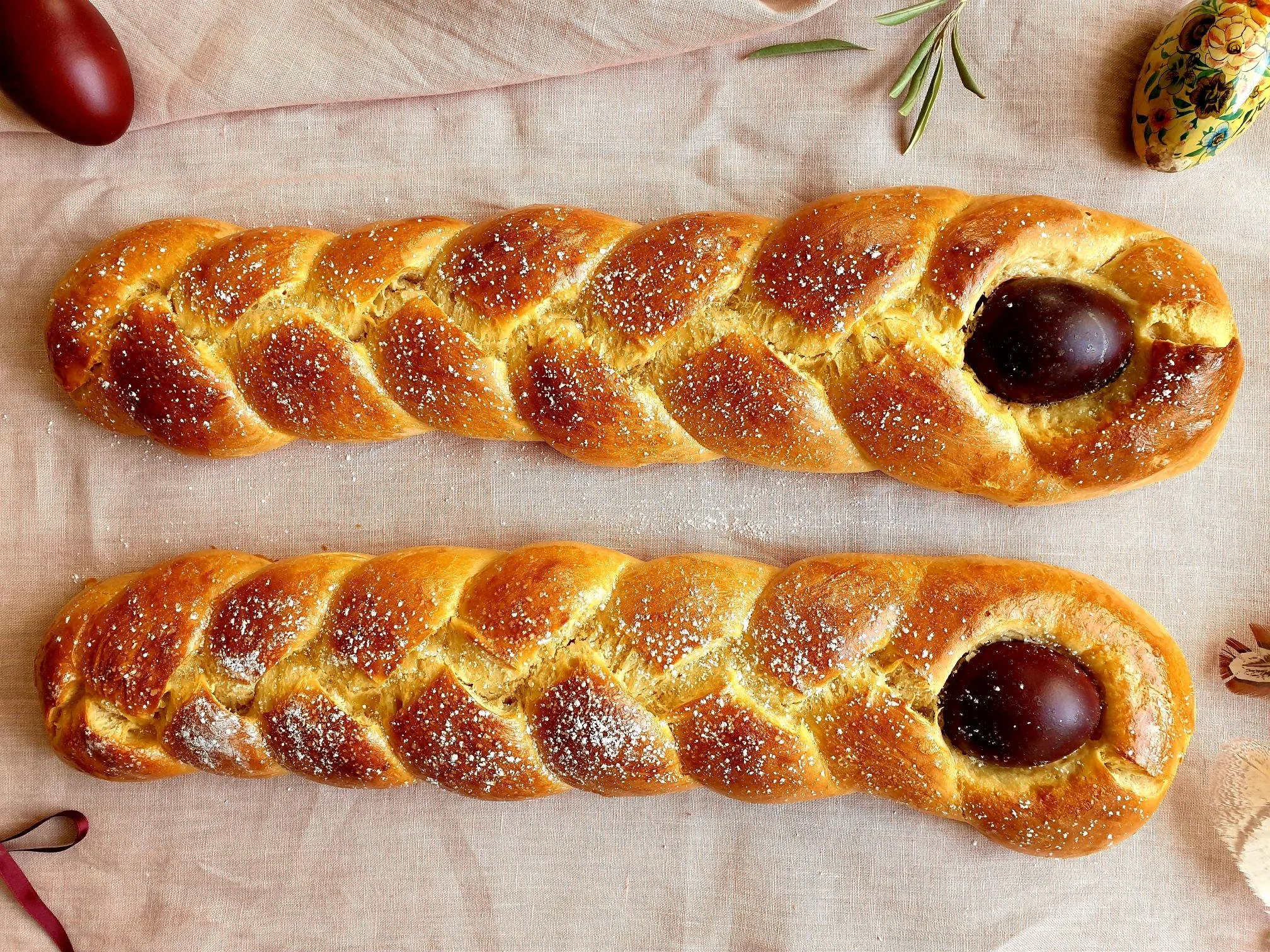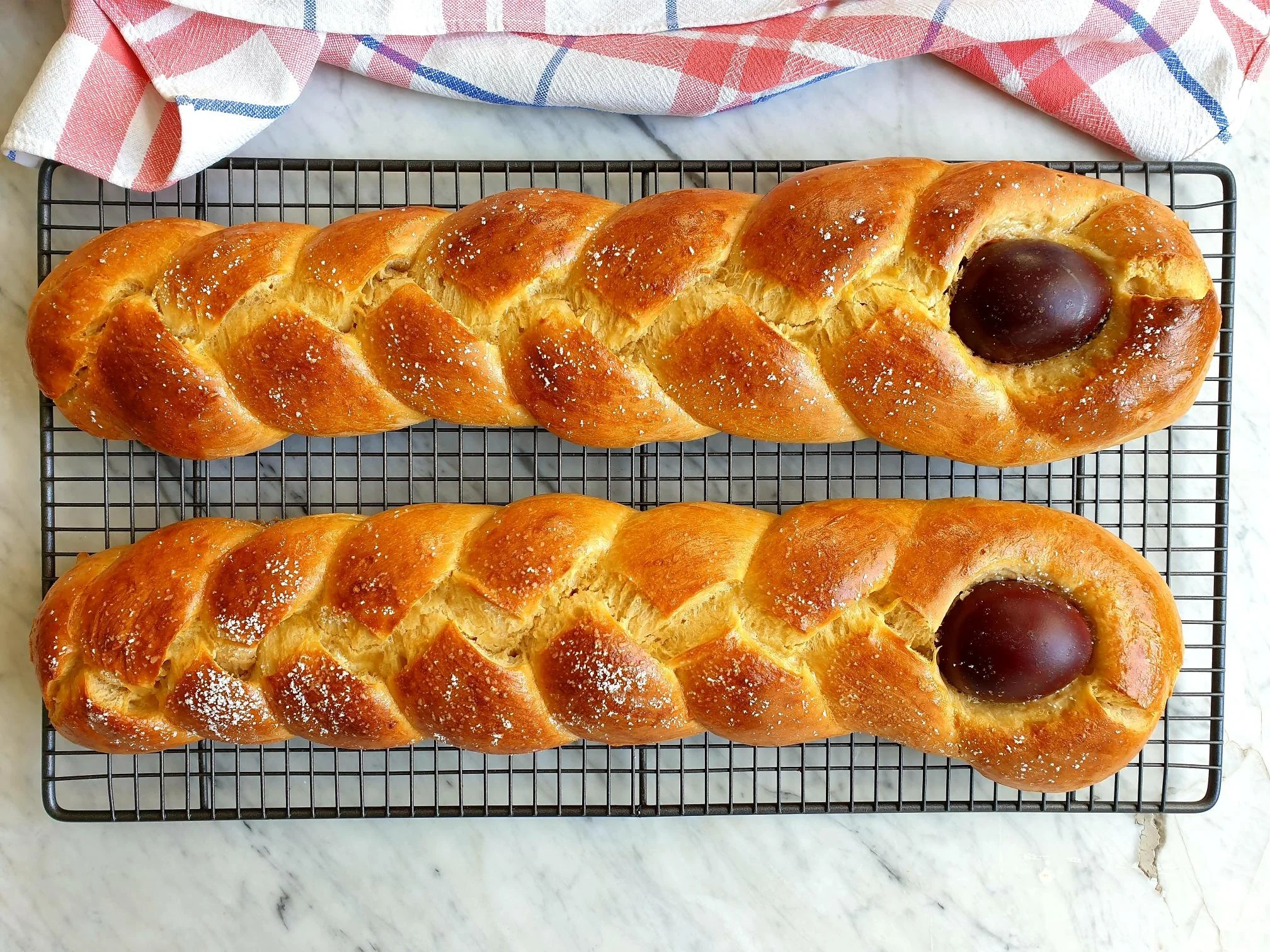Easter Sweet Plaited Bread (Tičice) Istrian Recipe
This celebratory sweet bread is similar to Jewish Challah, and is very flavoursome, soft and fluffy. It is made with yeasted enriched dough, and is shaped into a plait (or braid), and decorated with hard boiled eggs. It is very popular and traditionally baked during Easter festivities in Slovenian and Croatian Istra, Dalmatia (in Croatia) and in neighbouring Trieste in Italy and its surrounding areas.
It is best eaten fresh straight away, on its own with tea, coffee, or sweet wine, or paired with, as is traditionally the case, with cooked ham, and a selection of cheeses or cold dry cured meats. It is equally very delicious toasted the following day with some butter or jam.
This traditional recipe for sweet bread can be distinguished from other recipes for sweet bread across Europe by the addition of dark rum or grappa in the dough for extra flavour, and by the quantity of eggs used. This makes the bread have a heavier and slightly denser texture and richer taste, but this also means that it also requires a longer proofing time.
The eggs in the bread have symbolic significance in Christianity. Eggs represent new birth, new life, and are a reminder of the Passion and Resurrection of Christ. Traditionally, new converts to Christianity were baptised on Easter Sunday, representing their new birth in the faith, and new life in the Church. During the Middle Ages eggs were also a real treat to eat on Easter Sunday since they were forbidden during Lent, the 40 days of fasting before Easter.
Most of the time every household back home would bake two kinds of bread: the dough would be divided in half, and one kind is pinca bread, and is shaped like a regular round type of bread, but with cross-shaped incision on the top (representing Christ’s Crucifixion), and the other kind of bread, using the other half of the dough, is tičice, the braided variation with a hard boiled egg.
I am sharing here the recipe for this very traditional Easter sweet bread that has been made in my family for generations, it will make your holiday even more special!
Recipe
Method
This recipe will make 2 braided breads.
To make sweet bread plait, follow the recipe for basic sweet bread (pinca).
After the dough has risen and doubled in volume, remove it from the bowl.
Tip it onto a lightly floured surface and divide the dough in half.
Divide one half of the dough into 3 equal parts (cover the other half of the dough with the tea towel to prevent it from drying).
Roll each piece of the dough into 3 logs.
Join and pinch the ends of all 3 logs together to start shaping them into a braid.
Pinch the opposite end of the braided dough together.
Place it on a baking tray previously lined with baking parchment.
Repeat the process with the other half of the dough.
Decorate the plait with hard boiled eggs (you can use the eggs previously decorated and dyed, see my recipe how to decorate and dye the eggs, Easter Eggs Dyed with Onion Skins Recipe). Place hard boiled eggs at the end part of the braid, pressing down a bit, almost creating a little nest where the egg can sit.
Brush both plaits with the egg whites.
Allow braided loaf to rise in warm, draft free, room for about 1 hour.
Bake in the preheated oven at 180C for about 30 minutes, tent it with the aluminium foil halfway through if the top starts browning too much.
Once baked, take from the oven.
Transfer on a cooling rack and let it cool a bit.
Best served fresh still a bit warm.
Just a thought
Best eaten freshly baked on the same day.
Store leftover sweet bread in an airtight container for up to three-four days.
You can toast the slices and enjoy them with butter, jam, peanut or almond butter or use it to make French toast or bread and butter pudding, delicious!
Wine suggestion
Fior d'arancio Colli Euganei Spumante Dolce DOCG 2021 - Alla Costiera












